Habiter avec la mer, Jacques Rougerie
from 9 March to 12 May 2024Exposition d’Architecture, Jacques Rougerie, Habiter avec la mer
LIVING WHY THE SEA
In 2024, Villa Noailles explores the influence of the sea on architecture by dedicating a monographic exhibition to Jacques Rougerie, a globally renowned French architect, academician, and specialist in marine, underwater, and coastal habitats. Life began underwater 3.8 billion years ago, and Jacques Rougerie invites us to return to it.
Seas and oceans cover 71% of the Earth’s surface. Jacques Rougerie identifies himself as a “Mérien,” in contrast to the term “terrestrial,” thus shifting architecture from Earth’s gravity to Archimedes’ buoyancy. Since the early 1970s, this persevering oceanographer architect has been designing underwater habitats in collaboration with oceanographers, biologists, and engineers, grounded in solid scientific explorations – not utopia but anticipation.
His research, exploring the similarities between life and technologies in the worlds of space and underwater, leads him to design architectures dedicated to space and the Moon. Jacques Rougerie personally tests the prototypes of underwater habitats, using every imaginable means. He lives with and under the sea, even participating in a world record by spending 71 days in an underwater habitat in the USA in 1992. The sea is his way of life, and he aims to share it.
His “Mérien” project unfolds at all scales – from the body and clothing to underwater habitats and urbanism. Whether above or below water, Jacques Rougerie’s architectures shift the reference point from an Earth-bound attraction. Here, architecture floats and often submerges, signifying not a departure from the world but immersion into a realm no longer tailored to human scale. As allies of biodiversity, the marine fauna and flora in these bio-inspired architectural projects are illuminated by a new diplomacy of life.
Projects like the Archéoscope envisioned for the Gulf of Giens in Hyères, the Aquabulles for the Embiez Islands, the underwater house Galathée for Osaka, and the flagship project SeaOrbiter: International Oceanic Station, akin to the ISS, are international achievements with enigmatic names presented at Villa Noailles. Their forms, inspired by living characteristics and depicted like comic strips, evoke science fiction in its most direct sense: a scientific fiction where humans have left Earth for a liquid or space life.
In 2009, he establishes the Jacques Rougerie Foundation at the Institut de France, housed at the Académie des Beaux-Arts. Through its annual International Innovation and Architecture competition dedicated to the future of coastal development, underwater, and space habitats, the Foundation supports projects by young architects, engineers, and designers. Jacques Rougerie gives lectures worldwide on prospective architecture, blending Arts, Sciences, Technologies, and Nature.
Through a selection of projects, the curators trace Jacques Rougerie’s journey from his early experiences in the 1970s to the techno-enthusiasm of the 2000s, continuing with Sophie Rougerie and Emmanuel Dujardin through their Architecture Firm Rougerie + Tangram. They are notably the architects of the Olympic Marina in Marseille for the 2024 Olympics. The exhibition features numerous original drawings from Jacques Rougerie’s personal archives, some presented for the first time, and a collection of his models, including one of an underwater village borrowed from the Centre Pompidou’s collections. Additionally, the underwater habitat Aquabulle, experimented with numerous times in the Mediterranean, especially off the coast of Hyères, is displayed on the forecourt of Villa Noailles. A catalog is specially
published with texts by Jacques Rougerie and contributions from MBL Architects and Emmanuelle Chiappone- Piriou, an architect, and historian.
EXCERPT FROM A 2023 CONFERENCE BY JACQUES ROUGERIE
Jacques Rougerie is an architect, oceanographer, and member of the Academy of Fine Arts. He designs
underwater living and research spaces, museums, and sea centers, drawing inspiration from biomimicry. In 2009, he established the Jacques Rougerie Foundation, which rewards young architects for innovative projects related to coastal, marine, and space environments.
“I want to share with you the conviction that the destiny of future civilizations will emerge from the depths of the oceans and the mysterious expanses of the cosmos.
As a child, we often dream of building treehouses. I always dreamt of building them under the sea or in space.
These visions took root in me from an early age, on the distant beaches of Africa where the ocean imprinted its wave song on me. In the evenings, my gaze would shift from the ocean’s horizon to the stars to give shape to my dreams and passions, fueled by the desire to become an explorer of the future.
Like Saint-Exupéry’s Little Prince, I dreamed that the underwater world and the world of space would unfold before me!
The novels of Jules Verne, “20,000 Leagues Under the Sea” and “From the Earth to the Moon,” nourished this vision.
Later, I was fascinated by the achievements of Gagarin venturing into space and those of Commander Cousteau submerging the world’s first underwater habitat.
Both, in the same year, opened the doors to a future that would shake and guide my destiny and that of civilizations.
Later, fortune allowed me to dive aboard the Calypso, alongside Commander Cousteau, who introduced me to the marvelous world of the underwater. This led me to conceive and realize my first underwater habitats, envisioning an oceanic exploration for a new civilization, that of the Mériens.
The Mériens are those women and men who explore and desire to live in harmony with the underwater universe.
Today, through scientific research, innovation, technologies, and bio-inspired architecture linked to these realms, we can glimpse what the ocean and space will bring to the future of terrestrial life.
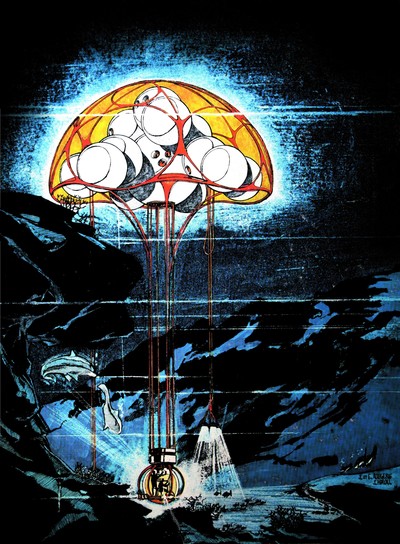
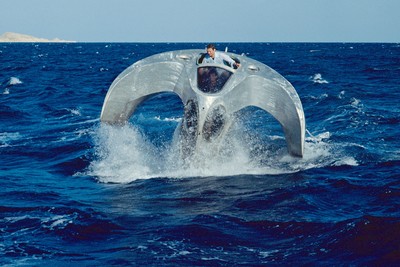
That’s why it becomes fundamental for these oceanic or space explorations to be conducted on an international scale, as they are essential to the evolution of our societies, to increase our resilience and ensure a sustainable future!
However, we must be aware of the current questions of the youth regarding the future of sciences, technologies, the concerns their developments raise, and their impacts on the environment. It is essential to debate and search for solutions together rather than opposing.
Yet, we have no choice but to trust in sciences and technologies; they are mere tools in service of a vision, an ambition, a project that must be humanistic and universal, reflecting the ideals of the Enlightenment, much like France.
In this spirit, we must together face these challenges. It is with this awareness that I have guided my research for many years in a quest for balance between nature, sciences, technologies, and art.
Through art, we must aspire to keep imagination and dreams at the core of what has always guided humanity. We must also implement new dreams that stimulate evolution and progress.
TOWARDS BIOMORPHIC ARCHITECTURE
With this mindset, in collaboration with multidisciplinary teams, we wanted to participate in shaping our future, conducting research at the core of humanity, directing developments towards bio-inspired architecture drawn from the millennia-old genius of nature.
This quest for biomorphic architecture and technologies, I developed it by drawing inspiration from the visions and works of Leonardo da Vinci, who said to his students: “Go and learn from nature, where our future resides.”
From our first biomorphic studies on underwater habitats for an oceanic future, we took into account their
environmental impact, as well as the physiological and psychological consequences for humans caused by this new way of life.
Working with the spirit of a future-oriented architect, as seen in my initial drawings of bio-inspired underwater architecture inspired by the radiolarian skeleton. These structures are suspended between two waters, according to Archimedes’ principle, allowing divers access to the sea and better anchoring adapted to the configuration of the seabed.
These habitats gave rise to a spatial organization prefiguring an underwater village adapted to the management of oceanic resources, for a communal life of 250 Mérien aquanauts.
Immersed off the Virgin Islands in the U.S., suspended between -25 to -50m, this village was also conceived as a training base for astronauts, sharing with Mérien aquanauts the same similarities in life in extreme environments.
These visions definitively made me realize that I am a Mérien, a son of a new world. Let’s not be afraid to be the dreamers of these new worlds; let’s pursue our dreams! We should never abandon them.
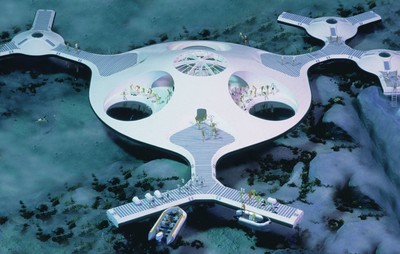
I went all the way with my dreams while remaining a very pragmatic dreamer, drawing and realizing underwater habitats for over 30 years.
Like with Galathée, my first underwater house. I not only dreamed, drew, and built it but also experienced it.
Galathée was designed for scientific research for 4 divers. It was developed to have a minimal impact on the marine ecosystem.
As for the interior, it was conceived with ergonomics adapted to underwater life, for stays of a month or even longer durations.
Before Galathée, we created different underwater refuges, the Aquabulles.
Like a playful buoy, thanks to their fully autonomous simplicity, these refuges position themselves at different depths, allowing 3 divers to observe biodiversity for several hours or for underwater archaeological research.
Then, we built and experimented with several underwater habitats, Hippocampe I and II, as well as Ocean Observer. Ocean Observer was designed for observing underwater life. We tested it in the Indian Ocean off the coast of Sumatra, Indonesia. The setup consisted of a surface floater where the energy groups connected to the underwater habitat were located.
During one experiment, we faced a violent cyclone, unexpectedly, which sent the habitat to a depth of 4000 meters. Needless to say, this kind of trial brings its share of emotions and adrenaline!
As for Hippocampe, we immersed and experimented with it at -12 meters, off the coast of Marseille in the Calanque de Pomègues at Frioul, in the same place where Cousteau had installed his first underwater house, Pré Continent 1.
The experience was conducted with divers from the National Navy and COMEX; it was in December, allowing us to organize a Christmas under the sea.
We invited 2 child divers, aged 10 and 12, to join us in the habitat to search for their gifts in their fins. A magical, unforgettable moment, a world-first broadcast worldwide. I can tell you that today it still remains their most beautiful Christmas!”
In these underwater experiences, just like an astronaut in space, the Mérien must relearn to coordinate and master movements, balance, orientation, and concentration.
Under the sea, as in space, our senses explore new sensations, awakening an imagination different from that of Earthlings or even sailors. Under the sea, you become a Mérien, leading you to develop a different philosophy.
The five senses no longer have the same perceptions. Movements are slower, touch lacks the same sensitivity, and the voice becomes higher-pitched.
Yet, it’s truly sublime—you cannot imagine the happiness of living under the sea for a moment. Working, having lunch, relaxing while listening to music with aquatic sounds, sleeping, waking up under the ocean surrounded by biodiversity; you live in harmony with the underwater world. It’s also the freedom to leave your habitat at any time to glide like in this photo, among the fish, like a bird in the air.
These are perceptions similar to weightlessness in a parabolic flight, which I was fortunate to experience,
creating such emotions that it’s difficult to come back to earth. I felt these sensations in my various underwater experiences or during a stay in the underwater habitat La Chaloupa in Florida, in the company of astronauts Volodia Titov, the first man to live a year in space, accompanied by my friend Jean-Loup Chrétien, who opened the doors of space to me at the Star City in Russia and at NASA in
the United States.
Shortly after, in the same habitat, I had the pride of participating in the world record of 71 days underwater.
The success of such challenges can only be achieved through teamwork, trust, mental strength, and
commitment.
When you return to Earth like astronauts, you only have one desire: to go back! Your perception and view of the world are no longer the same.
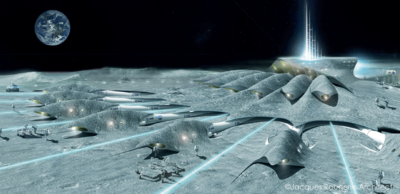
It is important that art accompanies these oceanic or space explorations, especially since astronauts or
Mériens often want to develop their imagination and unleash their artistic creativity in the fields of painting or sculpture, in harmony with these universes so different from what we experience on Earth.
Or, like astronauts Jean-Loup Chrétien or Thomas Pesquet, playing cosmic-sounding music in space. Or
Mériens like Julie Gautier, in a splendid underwater choreography, or Michel Redolfi, composing underwater music on a xylophone.
Listening to these subaquatic music, I came up with the idea of feeling the heartbeat of our planet, so that we become aware that our celestial body is indeed alive. This led me to create an opera on the water, with two blades emerging from the ocean like a tuning fork, capturing telluric waves to create a symphony of the Earth that can be heard worldwide at every sunrise, thanks to satellite broadcasts on social networks.
We have imagined another exciting project for a mythical race from Earth to the Moon using a space sailboat equipped with 4 solar sails, propelled by what is called solar winds, which are streams of particles consisting of ions and electrons.”
These projects have led us to work on various space concepts, including a lunar village capable of accommodating up to 250 astronauts with their equipment for long stays.
It will be largely constructed on-site, covered with lunar soil using 3D printers.
This innovative vision compels us as forward-thinking architects to constantly renew our perspective to imagine the extraterrestrial habitats of tomorrow.
I am aware that space and the depths of the underwater world remain inaccessible for most of you.
That’s why I wanted to put eyes under the sea, on ships, to offer the opportunity for all underwater
enthusiasts to finally see beneath the ocean surface without diving. Whether they are sailors, scientists, or
children. We materialized this concept on two types of semi-submersible vessels, shaped like Manta rays, the Aquascopes for 10 people and the Seacopes for 26 people, allowing continuous underwater observation through their large polycarbonate windows.
After building these semi-submersibles, I felt the compelling need to design and have my own ship
constructed. The Aquaspace, an aluminum trimaran measuring 22 meters in length by 8 meters in width.
With a central hull, entirely transparent for nearly 20 meters, it allowed me to observe the underwater world during long oceanic crossings, witnessing biodiversity and whale migrations, as you can see.”
This passion for the sea has led us within our architecture firm, Rougerie Tangram, to conceive and realize the ports of the future. It is this determination that has allowed us to be the architects for the Paris 2024 Olympic Games’ marina in Marseille.
It will remain as a legacy for all the people of Marseille after the games, providing them with a better understanding of the opportunities offered by the Mediterranean Sea.
This low-carbon marina is Effinature certified, attesting to biodiversity in coastal and urban environments.
To address the significant oceanic challenges, transmit knowledge, and inspire future maritime vocations, we have, within our architecture firm, created several large scientific and educational museums dedicated to the sea worldwide, including:
In France, Océanopolis in Brest, Nausicaa in Boulogne-sur- Mer, the largest European center on marine environment. And in the bottom right, the Sea Museum, inspired by the nautilus, located in Qingdao Bay, China, and the Pavilion of the Sea in Kobe, Japan.
And most recently, the Fare Natura ecomuseum in Moorea, French Polynesia. Its biomorphic architecture
draws on traditional Polynesian elements.
Located on the lagoon’s edge, it borrows from the marine and plant world its vocabulary of forms to express the meeting between the sea and the land.
It is essential to reconnect with the sacred and ancestral bond that unites us with nature, much like the Polynesians who have integrated the ocean into their behaviors and ways of life.
Other maritime and aquatic peoples throughout history have found this connection with the ocean and water by building their capitals and cities on the water’s edge, rivers, lakes, coastlines, and even at sea for commercial, war, and recently…touristic and sporting reasons. Each time, these cities give rise to a cultural and artistic identity imbued with aquatic surroundings.
Examples include:
The Tofinous, “men of the water,” in the lake city of Ganvier in Benin, Africa,
The Uros and their floating homes on Lake Titicaca in Peru, The Badjaos and their stilt houses in the open sea in the Philippines,
Or the Venetians with the most beautiful water city: Venice, which has always fascinated me, it is timeless.
Our civilization should draw inspiration from the respect shown by Water Peoples for the ocean, as the ocean, with its biodiversity, plays a crucial role as the vital lung of our Earth spaceship, providing oxygen, energy, covering 71% of its surface. Yet, its underwater universe remains mysterious and largely unknown.
The ocean is an immense and precious world from which biotechnologies, renewable energies of the future, food, future pharmacology, new materials, and many other discoveries can emerge for the development of a blue economy based on sustainable management of natural resources.
Humanity has always been intimately connected to the oceans and marine shores. Today, our civilization, across all continents, is increasingly drawn to the coast and the sea. If we observe the luminous density of planetary coastlines from space, we see the demographic pressure they undergo.
Currently, we are 7 billion, with half living near the coast. By 2050 - which is tomorrow - we will be nearly 10 billion, with 75% living near the sea, more than 7 billion people who will have to share this space.
Moreover, this maritime fringe is one of the world’s most fragile ecosystems, undergoing the impact of various pollutants and, head-on, the effects of climate change and rising sea levels. It is urgent to act and essential to change our behaviors by inventing new paradigms for coastal development, global management of seas and oceans, as well as that of water, which are the major challenges of the 21st century.
These climate changes linked to rising sea levels could lead to more than 600 million climate refugees worldwide, mainly affecting maritime peoples in developing countries. It is unimaginable to accept.
We propose several solutions at different scales, from small or large coastal or island territories, depending on the complexity of the location, be it geographical, societal, cultural, or economic.
For example, this project of a floating city of about 5,000 inhabitants living off fishing, on the atoll of Maupihaa in French Polynesia. We designed it to allow this maritime people to stay on their ancestral territory and avoid becoming climate refugees.
The bio-inspired village is entirely created from articulated floating structures that incorporate the latest
environmental technologies to minimize their impact on lagoon biodiversity.
To find new solutions, we must not oppose the sea and its marine dynamics but work with it. Sailors and Mermen know this.
And we must avoid catastrophic or anxiety-inducing discourse.
Let us trust in the creative and adaptive power of humanity, science, technologies, as well as visionaries
and the extraordinary potential of artificial intelligence and collective intelligence to shape a sustainable and exciting future.
It is this mindset that I wish to convey to the young multicultural generation because they carry within them
the genes of dreams in the face of the challenges they must overcome to protect and build their future.
As you will see in this Foundation film presenting the laureates, these young people project themselves with enthusiasm and generosity, 20, 50, 100 years ahead. It is this audacity of these young creators that will allow the imagination of new forms of habitats, living environments, and mobilities adapted to our societies, inventive and efficient for the 10 billion humans we will be in 2050, of which 75% will live near maritime shores.”
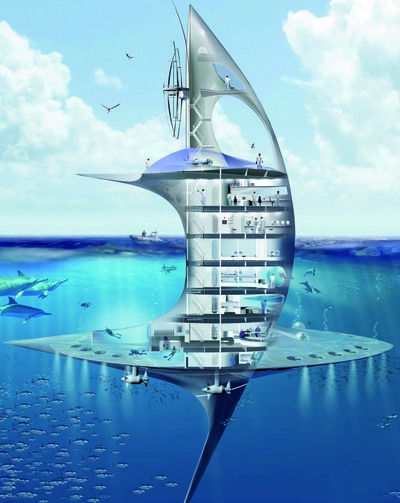
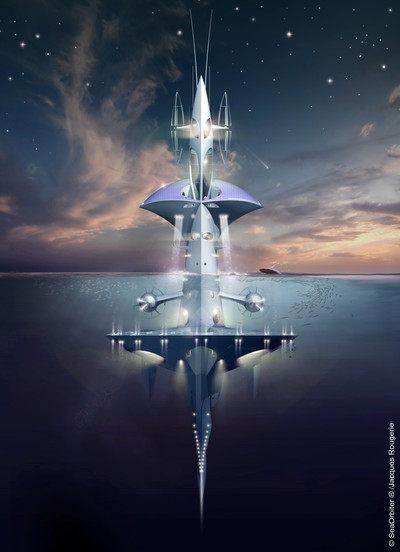
It is with this conviction that I founded the Fondation Jacques Rougerie - Space and Sea Generation in 2009 at the Institut de France, hosted at the Académie des Beaux-Arts, under the presidency of H.S.H. Prince Albert II of Monaco.
The foundation encourages passion, audacity, and aims to inspire vocations that combine art, science, and
technology with nature. Each year, the foundation awards various international prizes in art, architecture, and innovation related to themes of the sea or space, as well as addressing major climate challenges such as rising sea levels, in partnership with UNESCO.
Since its inception, we have received over 12,000 applications from 150 countries, creating a database of
several thousand projects contributing to envisioning the world of tomorrow.
A prestigious jury of international experts discovers and honors passionate architects, engineers, and artists each year. By supporting the efforts of these young individuals, you become contributors to a new society for a resilient and sustainable future.
Einstein once said, ‘Imagination is more important than knowledge.’ Jules Verne also asserted, ‘Anything that one man can imagine, other men can make real.’ I have always been true to this maxim by conceiving forwardlooking projects for over 30 years.
The project that embodies this dream, this realism, and synthesizes three decades of underwater research and experiences that I have led, is SeaOrbiter, the international ocean station, akin to the ISS of space.
Humanity has always needed strong symbols. SeaOrbiter should be one.
SeaOrbiter challenges established paradigms and creates a new concept of a ship, unique in the world,
dedicated to universal scientific, educational, and societal exploration of the oceans, much like the ISS does for space.
Imagine. Picture a silver vessel drifting with the major ocean currents, at the heart of the oceans.
Its mission: to explore and analyze a still largely unknown ocean, from the surface to great depths, over periods ranging from 6 months to 1 year. The SeaOrbiter project has garnered interest and support from the international oceanographic scientific community, including organizations like Ifremer, as well as space agencies such as NASA, which intends to use it as a training center.
This revolutionary vessel, with its bio-inspired structure resembling a seahorse, reaches a height of 57 meters and accommodates a crew of 24 people. It consists of 12 decks designed to meet the needs of scientific activities with laboratories, providing living spaces, a command center, underwater observation areas, and even a saturation living quarter allowing eight aquanauts to live underwater 24/7 for extended periods. The ergonomics of the spaces are designed to ensure harmony between the Mermen aquanauts and this specific environment. The vessel will host multiple exploration devices.
SeaOrbiter will enhance our understanding of the ocean’s functioning and its crucial role for the planet,
encompassing biodiversity, climate, and various other data. It will also pave the way for research and
development of new technologies.
And because art and culture are essential to this human adventure, a modern-day Nautilus organ is integrated into the communication room, continuously broadcasting scientific discoveries and life on board.
This project, conceived 20 years ago, has been revitalized thanks to my perseverance and the support of President Emmanuel Macron and Rodolphe Saadé, President of CMA CGM, a partner of SeaOrbiter. We are currently incorporating the latest low-carbon technological and energy developments into the first SeaOrbiter to address current environmental challenges, with construction scheduled for 2025 and operational readiness by 2027. If all goes well, this first ocean sentinel will eventually be joined by 7 others across all the oceans.
All these projects and achievements you have just seen have come to life thanks to encounters with exceptional women and men who have expanded my horizons and opened up fields of possibilities. I have always been convinced that the destiny of future civilizations will arise from the ocean and space. It is the intensity of dreams that we realize that gives life meaning and taste.
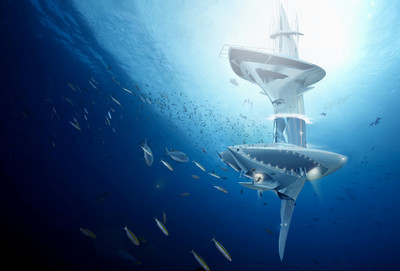
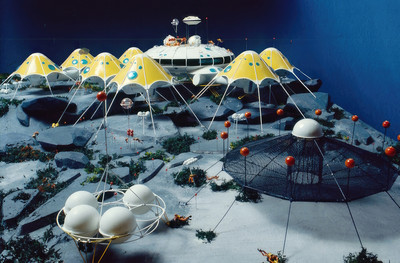
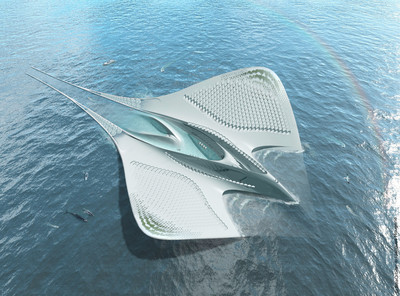
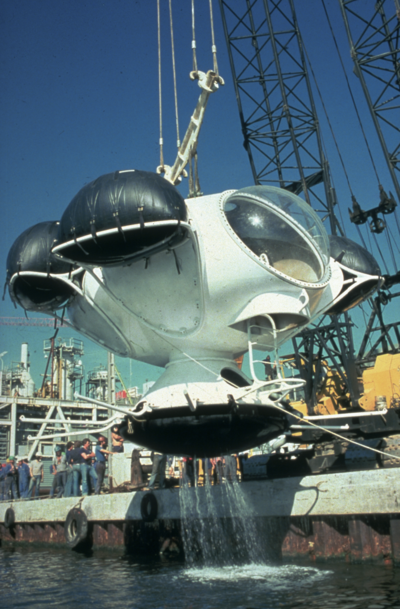
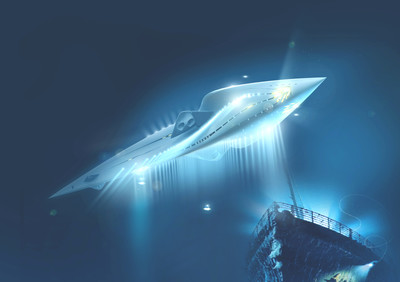
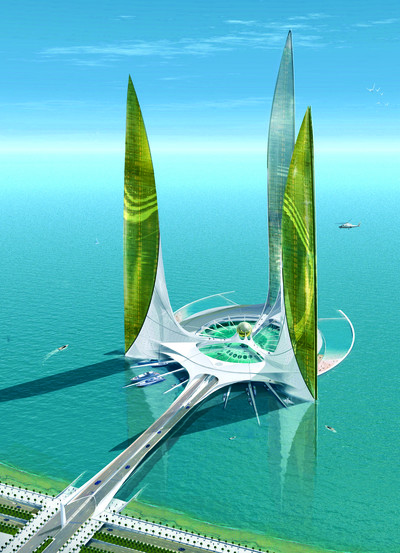
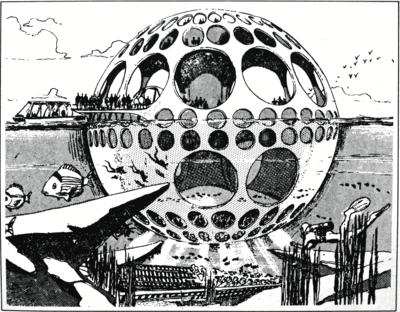
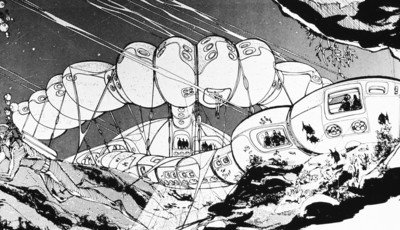

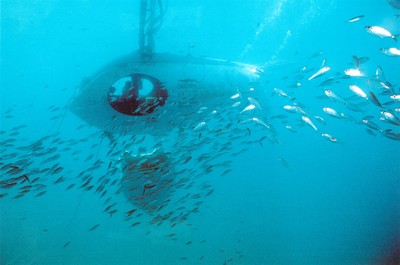
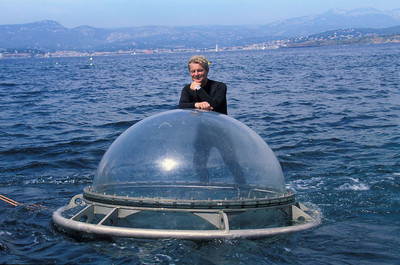
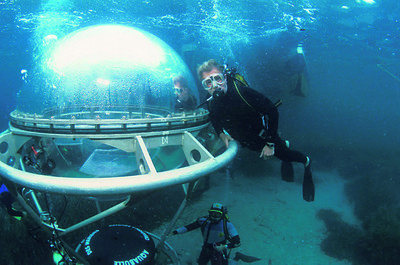
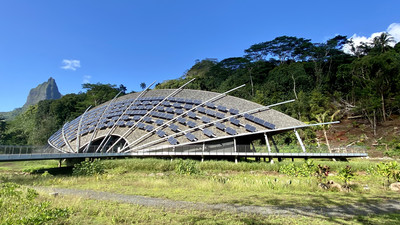
Jacques Rougerie est un architecte visionnaire français de renommée mondiale, académicien, explorateur du futur, spécialisé dans le domaine des habitats marins, sous-marins et littoraux.
Passionné par la mer et l’espace, il fonde son travail et ses innovations sur une architecture bio-inspirée, résiliente et durable.
Son projet emblématique « SeaOrbiter », constitue le point d’orgue de toutes ses réalisations. Il est à l’image de l’ISS dans l’espace : une station océanique internationale dédiée à la recherche scientifique, à l’exploration, à l’étude du climat et à l’éducation.
Jacques Rougerie développe depuis plus de 30 ans des projets de villages flottants ainsi qu’une base et un village lunaire. Il a réalisé plusieurs habitats sous-marins, Galathée, Hippocampe, Aquabulle… pour ne citer que quelques exemples des plus notables.
Avec l’agence Rougerie + Tangram et le Lab Rougerie + Tangram, il réalise en France et dans le monde,
notamment des musées de la mer, des centres sportifs et aquatiques et des grands équipements aéroportuaires et tertiaires et dernièrement, la Marina des Jeux Olympiques Paris 2024 à Marseille.
En 2009, il crée la Fondation Jacques Rougerie à l’Académie des Beaux-Arts, à l’Institut de France. Son
Concours International d’Architecture et d’Innovation annuel est consacré aux grands enjeux climatiques et environnementaux, relatifs notamment au littoral et à la montée des eaux ainsi que des projets liés aux mondes marin et spatial.
Cette Fondation encourage les jeunes à relever les défis planétaires actuels et futurs en conjuguant Arts,
Sciences, Technologies et Nature pour bâtir au niveau national et international les nouveaux cadres de vie
résilients et désirables.
Aussi, Jacques Rougerie donne des conférences dans le monde entier afin de communiquer, partager et diffuser ses passions.
1945 Naissance à Paris
1956 Découvre le film Le Monde du silence de Jacques-Yves Cousteau et Louis Malle et les livres de
Jules Verne.
1964-69 Formation d’architecte à l’Ecole Nationale Supérieure des Beaux-Arts,
1973 Projet de Village sous la Mer mandaté par la NOAA et la NASA
1974 Fondation du Centre d’architecture et de la Mer (CAM).
1974 Publication de Habiter la Mer, Architecture d’Aujourd’hui n°175, 1974.
1977 Projet d’un centre culturel d’archéologie sous-marine, l’Archéoscope, Hyères, Var.
1977 Réalisation et expérimentation de sa première maison sous-marine Galathée
1981 Réalisation du Pavillon de la Mer, Osaka-Kobe, Japon.
2008 Élu Membre de la Section d’architecture à l’Académie des beaux-arts - Institut de France.
2015 Lauréat du Concours international du Musée archéologique sous-marin Alexandrie.
2018 Réalisation du Centre européen de la Mer, Nausica à, à Boulogne-sur-Mer
2023 « Poétique du ruissellement » Discours à l’Institut de France, Académie des beaux-arts.
2024 Réalisation de la Marina Olympique, Marseille pour les Jeux olympiques 2024.
2025 Mise en chantier du Projet SeaOrbiter, Station Internationale Océanique.
MBL architectes est une agence d’architecture fondée par Sébastien Martinez-Barat et Benjamin Lafore, rejoint par Florian Jomain. Leur travail explore divers champs de la culture architecturale : constructions, publications, enseignements, conception d’objets et commissariat d’expositions.
Ils sont lauréats des albums des jeunes architectes et paysagistes pour leurs projets construits et commissaires des expositions d’architecture à la villa Noailles depuis 2016.
Équipe MBL : Benjamin Lafore, Sébastien Martinez-Barat, Florian Jomain, Nicolas Boulben.
